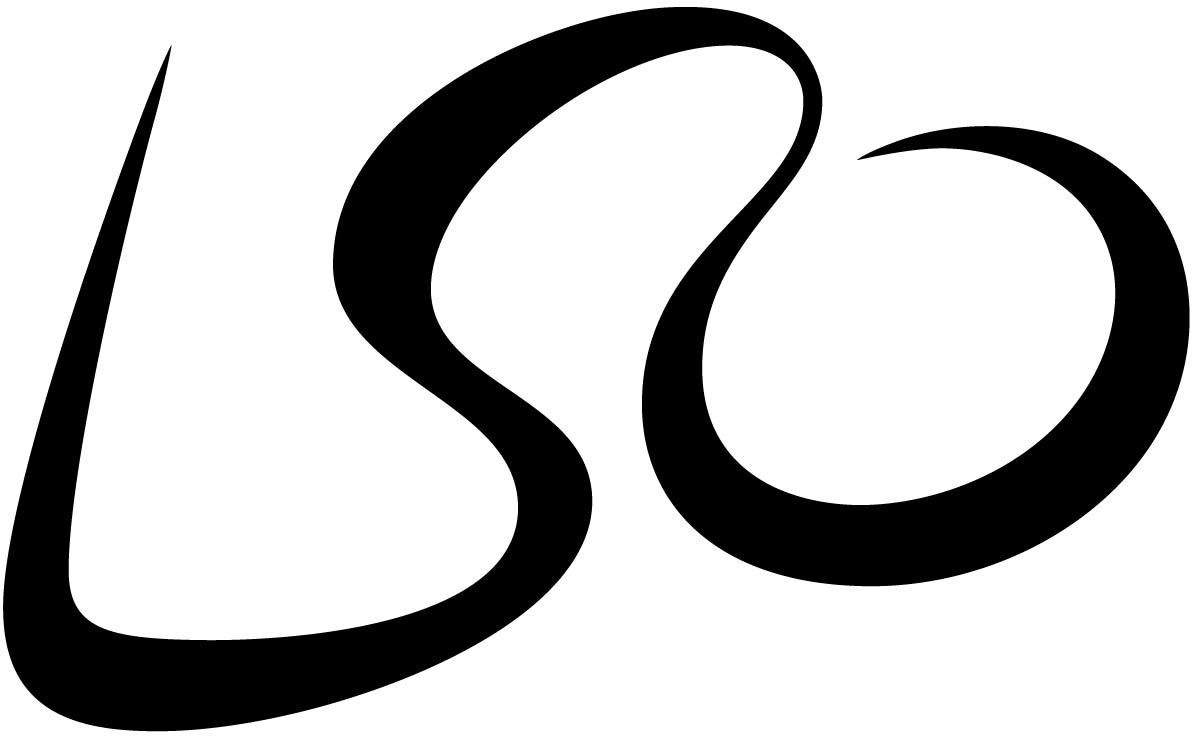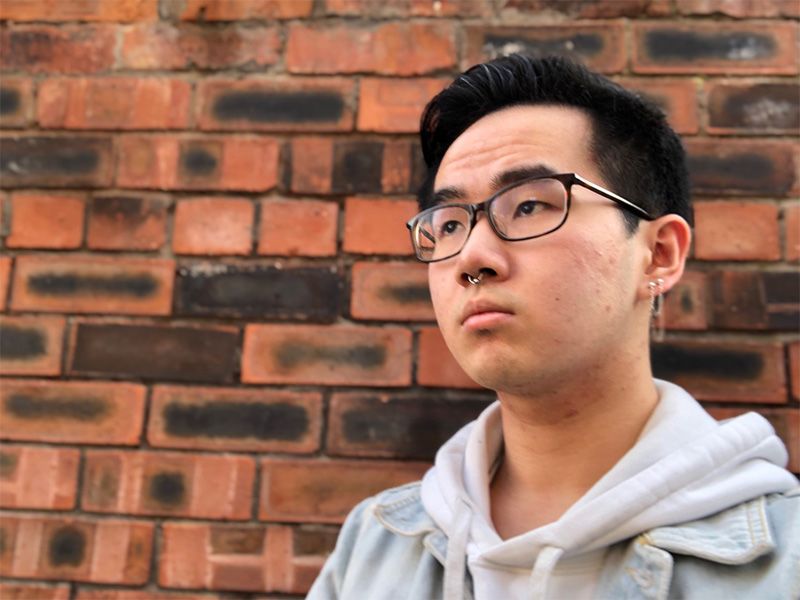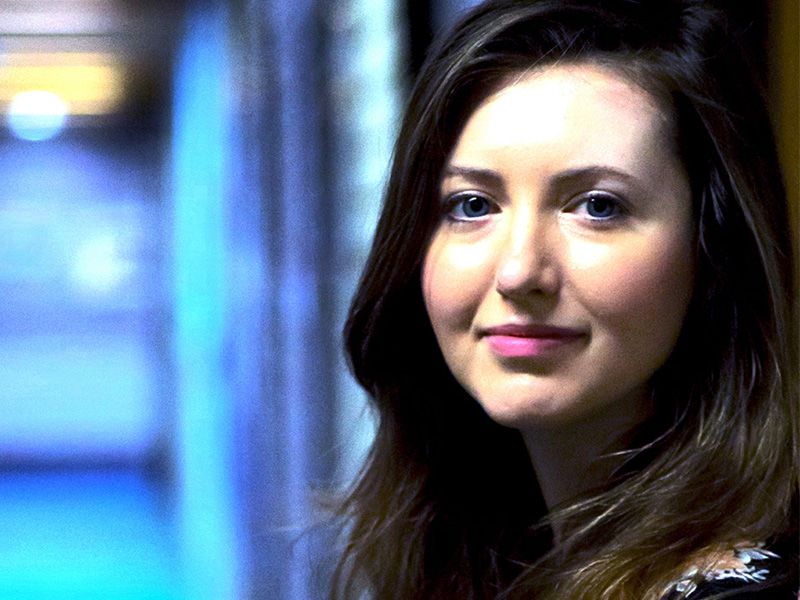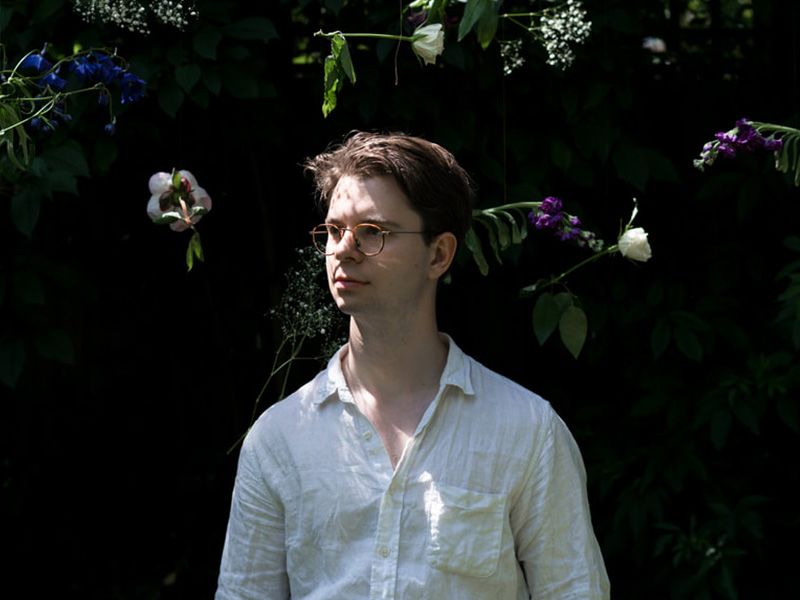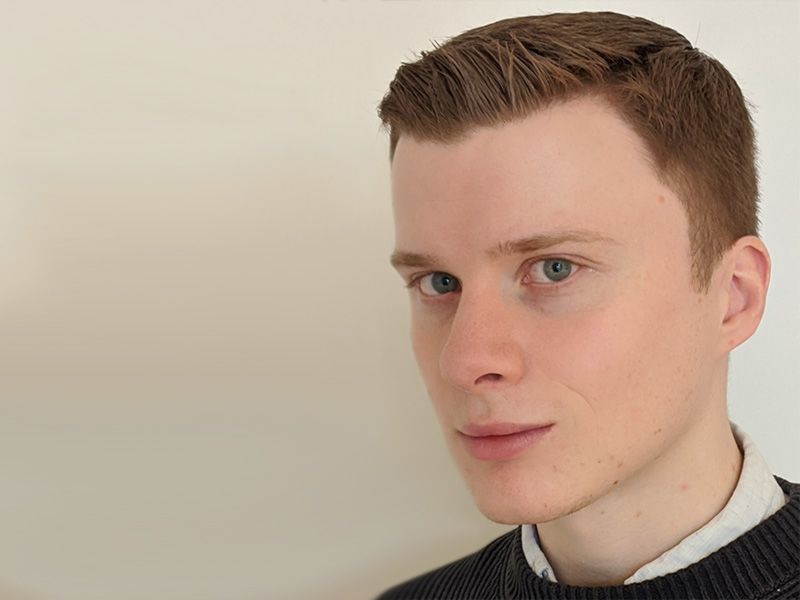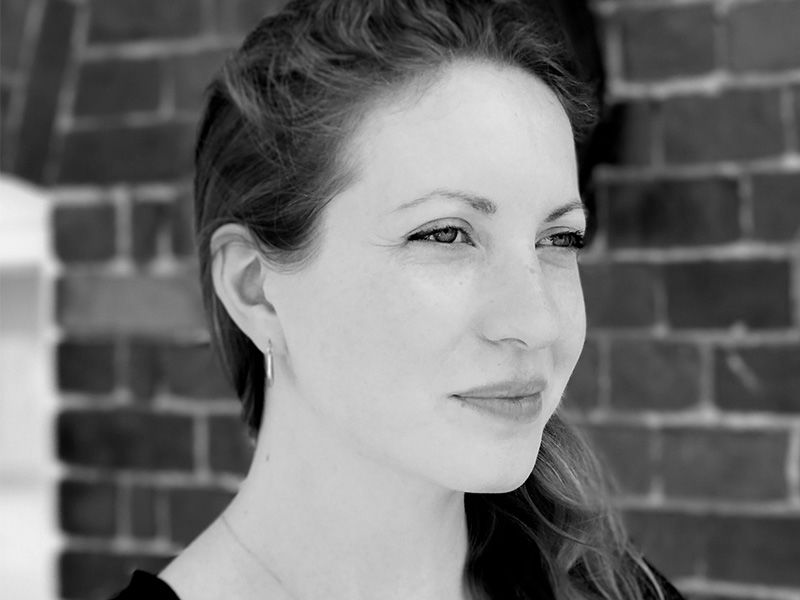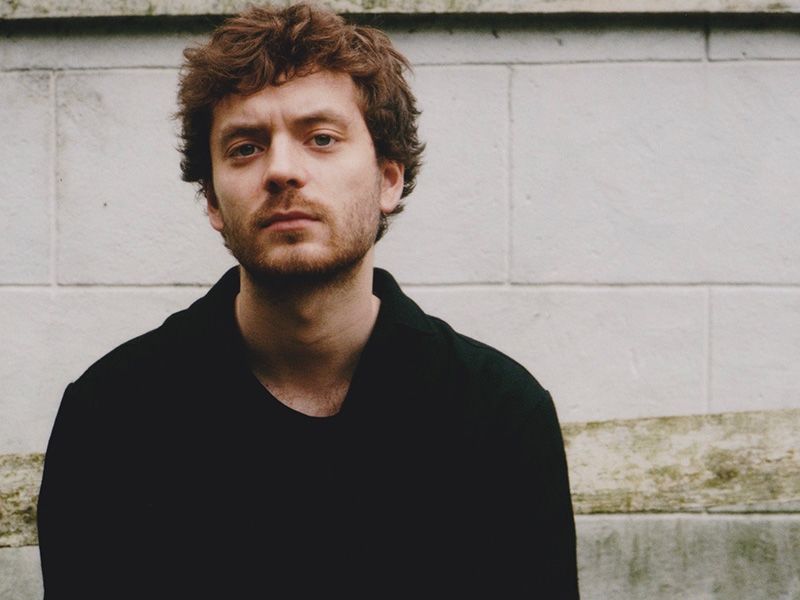London Symphony Orchestra
LSO Panufnik Composers present …
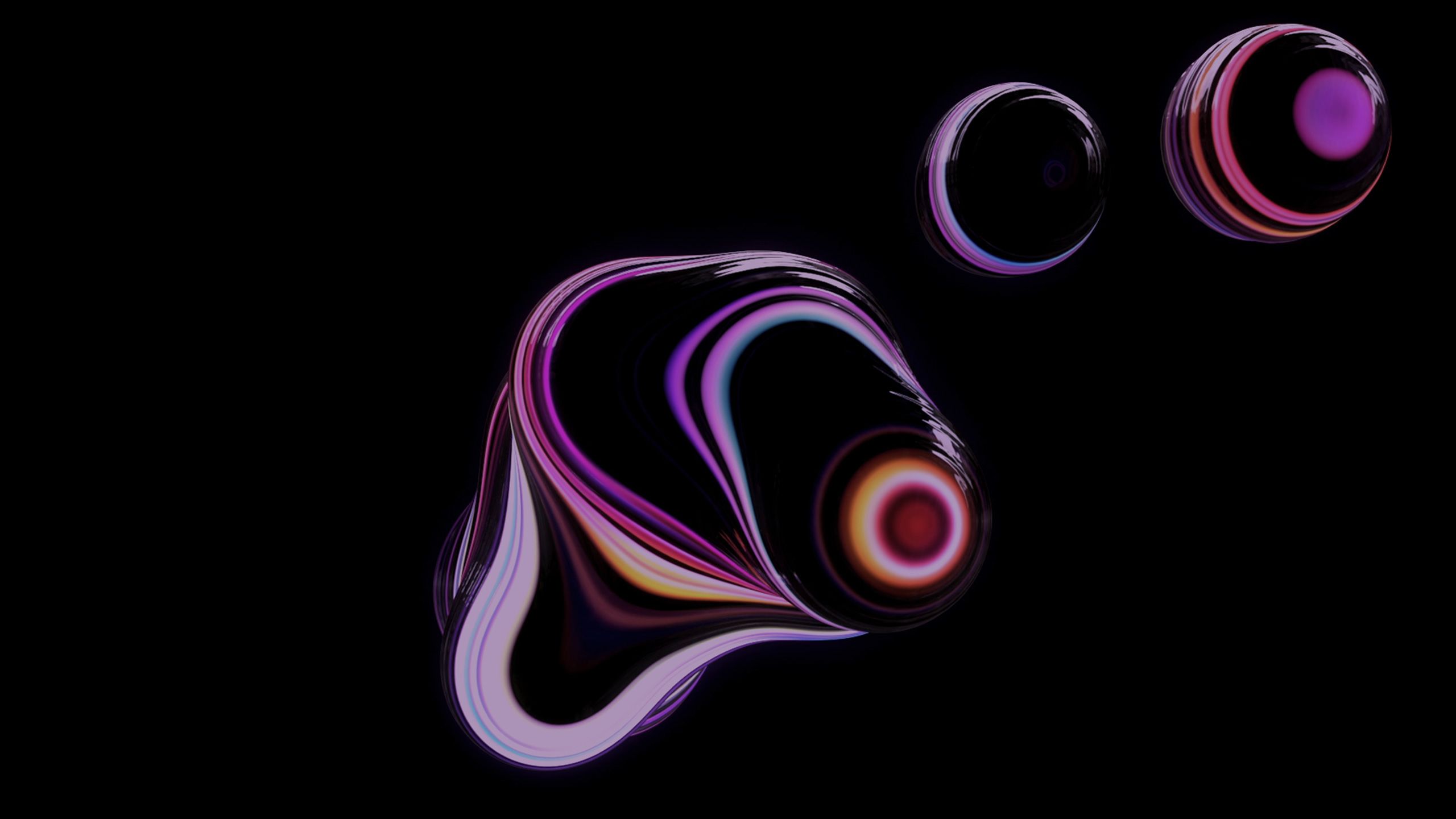
Welcome
Thank you for joining us for today’s broadcast, where we will hear six three-minute pieces for orchestra, developed by composers who were appointed to the LSO Panufnik Composers Scheme in 2019.
The experience of hearing one’s piece performed for the first time is a pivotal point in the composition process, and is a moment for which our composers have waited some twelve months, after the initial workshops of their pieces were unable to go ahead as planned in March 2020. It was with great joy then that we were able to come together behind closed doors in March 2021 to explore the diverse works created by these composers. In a first for the scheme, we are delighted to be able to share these performances – as recorded at the workshop sessions – with our audiences online, and to share a greater insight into the Scheme with introductions from our composers, mentors and musicians.
These workshops were conducted by Jack Sheen, himself an alumnus of the Scheme (2014). It was a pleasure to welcome him again to the LSO and we were grateful to him for stepping in to replace Principal Guest Conductor François-Xavier Roth, who has directed these workshops every season but was sadly unable to do so this year due to travel restrictions. We look forward to François-Xavier Roth joining us again next month, when he will conduct a concert devoted to 21st-century music, predominantly by alumni of the LSO Panufnik Composers Scheme.
Our sincere thanks to Helen Hamlyn and The Helen Hamlyn Trust for their long-term support of the LSO Panufnik Composers Scheme, to Colin Matthews and Christian Mason in their roles of Composition Director and Composition Support, and to Lady Camilla Panufnik, without whom this Scheme would not exist.
I hope you enjoy the broadcast, and that you can join us at LSO St Luke’s or the Barbican in person as we re-open our doors this month.

Kathryn McDowell CBE DL; Managing Director
Kathryn McDowell CBE DL; Managing Director
Sunday 16 May
Today's Programme
Ninfea Cruttwell-Reade Sleep-Chasings
James Chan Tanztheater
Caroline Bordignon Iridescent Flares III
Joe Bates Muted the Night
Jonathan Woolgar PROTO-SYMPHONY
Louise Drewett The Daymark
Jack Sheen conductor
London Symphony Orchestra
Colin Matthews composition director
Christian Mason composition support
Recorded at LSO St Luke's on Monday 8 March in COVID-19 secure conditions.
Broadcast on the LSO's YouTube channel on Sunday 16 May 2021.
About the Scheme
The Panufnik Composers Scheme offers six emerging composers each year the opportunity to write for a world-class symphony orchestra.
Guided by renowned composers Colin Matthews and Christian Mason, with additional tailored support, the scheme enables composers to experiment with and develop their orchestral writing skills through creating a three-minute composition over twelve months.
The resulting compositions are performed and discussed by the LSO and Principal Guest Conductor, François-Xavier Roth, in a public workshop rehearsal at the culmination of the scheme.
Two of the compositions are then chosen to be developed further, before being premiered by the Orchestra in an LSO concert at the Barbican.
The LSO Panufnik Composers Scheme was devised by the Orchestra in association with Lady Panufnik, in memory of her late husband, the composer Sir Andrzej Panufnik, and is generously supported by Lady Hamlyn and The Helen Hamlyn Trust.

Support the LSO's Future
The importance of music and the arts has never been more apparent than in recent months, as we’ve been inspired, comforted and entertained throughout this unprecedented period.
As we emerge from the most challenging period of a generation, please consider supporting the LSO's Always Playing Appeal to sustain the Orchestra, allow us to perform together again on stage and to continue sharing our music with the broadest range of people possible.
Every donation will help to support the LSO’s future.
You can also donate now via text.
Text LSOAPPEAL 5, LSOAPPEAL 10 or LSOAPPEAL 20 to 70085 to donate £5, £10 or £20.
Texts cost £5, £10 or £20 plus one standard rate message and you’ll be opting in to hear more about our work and fundraising via telephone and SMS. If you’d like to give but do not wish to receive marketing communications, text LSOAPPEALNOINFO 5, 10 or 20 to 70085. UK numbers only.
The London Symphony Orchestra is hugely grateful to all the Patrons and Friends, Corporate Partners, Trusts and Foundations, and other supporters who make its work possible.
The LSO’s return to work is supported by DnaNudge.
Ninfea Cruttwell-Reade
Sleep-Chasings
In the first section of his poem Sleep-Chasings (1860; later titled The Sleepers), Walt Whitman describes a vision of wandering through the night, seeing sleeping men, women and children in every situation. Babies in cradles, battlefield corpses, ‘livid’ drunkards, lovers, prisoners, the new-born and the soon-to-die: his vision visits them all; sleep is a democratic condition. ‘All, all sleep.’
Whitman’s poem is a long one (58 stanzas), but its compelling opening – a vision of humanity in all its shades – has inspired Ninfea Cruttwell-Reade’s short piece for orchestra. The piece is divided into four continuous sections, marked respectively ‘creeping’, ‘buoyant’, ‘blaring’ and ‘languishing’. The music of the first three sections closely matches its descriptor: 'Creeping' uses tickling, ‘mandolin’ pizzicato (played using the finger like a plectrum) and feathery flute tremolos; 'Buoyant' uses bouncing pizzicato glissandi and prickly wind grace notes; 'Blaring' uses herald-like brass fanfares. It’s not hard to imagine, with such strong musical imagery, the different characters of Whitman’s vision: perhaps the poet creeping at night, the restless children and the dying soldiers.
The final section, ‘languishing’, surely shows us the drunkards in the tavern, with bassoons and second clarinet marked ‘leering’. Yet it brings the other characters together as well, drawing out a wider aspect of Whitman’s poem, the way in which sleep and dreams allow us to to step between experiences and beyond our own identities.
Note by Tim Rutherford-Jones

Ninfea Cruttwell-Reade
Ninfea Cruttwell-Reade is a composer and cellist based in Edinburgh. Composing for old, new and damaged instruments, her past projects have included works for symphony orchestra, viols and theorbo, string and percussion quartets, a homemade glass harmonica, flower pots and a fire-damaged piano. In the last year she has received commissions from the Dunedin Consort, Chelsea Music Festival, Glyndebourne Youth Opera and Edinburgh Youth Orchestra. Five Letters from Aubrey Beardsley, her song cycle for countertenor and prepared piano based on letters by the 1890s art nouveau illustrator, was shared online in 2020.
Ninfea was the recipient of the Psappha Ensemble’s 2020/21 Peter Maxwell Davies Commission for which she composed a piece for sitar and chamber ensemble. The project was also supported by the PRS Foundation’s Composers’ Fund, enabling her to take sitar lessons with Jasdeep Singh Degun. She is currently a composer-in-residence at Glyndebourne and the Presteigne Festival’s ‘Evolve’ composer for 2020–25. In 2018 she was commissioned to write Table Talk, a large ensemble brass work for the Tanglewood Music Festival, and her composition Hatters was programmed at the festival the following year, performed by the Boston Symphony Orchestra percussionists. She has been a recipient of a composition fellowship from the Tanglewood Music Center (2017) and was awarded the UK’s Royal Philharmonic Society Composition Prize (2015), through which she was commissioned to write a work for the 2016 Presteigne Festival.
More from Ninfea
Five Letters from Aubrey Beardsley
Musical settings of letters by the art nouveau illustrator, Aubrey Beardsley, sent to friends in the final year of his life before his death from tuberculosis at the age of 25.
James Chan
Tanztheater
James Chan’s Tanztheater originated in two dance-related inspirations. The first a performance at the English National Ballet in April 2019 of Stravinsky's The Rite of Spring, a reproduction of dancer and choreographer Pina Bausch's legendarily visceral 1975 production. In Bausch's realisation the selection of the sacrificial girl is symbolised by the passing around of a red dress in atmosphere of absolute dread. The second for Chan was the 2018 supernatural horror film Suspiria by Luca Guadagnino, inspired by the 1977 film of the same name by Dario Argento. At the heart of both versions of Suspiria is a dance school run by a coven of witches, and a young dancer who must find a way to escape its terrors.
Seen a few months apart, Bausch’s choreography and Guadignino’s film came together for Chan in an orchestral exploration of physicality and magical transformation. The sound of breathing – wind and brass instruments breathing through their instruments, reeds removed as necessary – is heard throughout his piece, not as a rhythmic or meditative device, but as an asynchronous, communal respiration, like the anxious, effortful breaths of Bausch’s dancers. Beneath this respiratory surface, a transformation takes place as slow music for the lower strings gradually merges with faster, syncopated passages for the violins. Initially heard only very quietly, it then spreads across the whole orchestra before making way, finally, for the breathing once more.
Note by Tim Rutherford-Jones

James Chan
James Chan is a Hong Kong-born composer currently based in London. His music often inhabits a delicate and fragile sound world, and draws much inspiration from other art forms – from film to sculpture, with a predilection for the writings of Virginia Woolf and the paintings of Agnes Martin.
James is currently studying for an MMus at the Royal Academy of Music with Edmund Finnis and David Sawer. In 2020, he graduated from the ‘joint-course’ at the University of Manchester and the Royal Northern College of Music, where he studied with Gary Carpenter.
In 2016 James was announced as a winner in the senior category of the BBC Inspire Young Composer's Competition. He has since worked with a number of other ensembles and players, including the Psappha Ensemble and the NYCGB Fellows, and his music has been broadcast on BBC Radio 3.
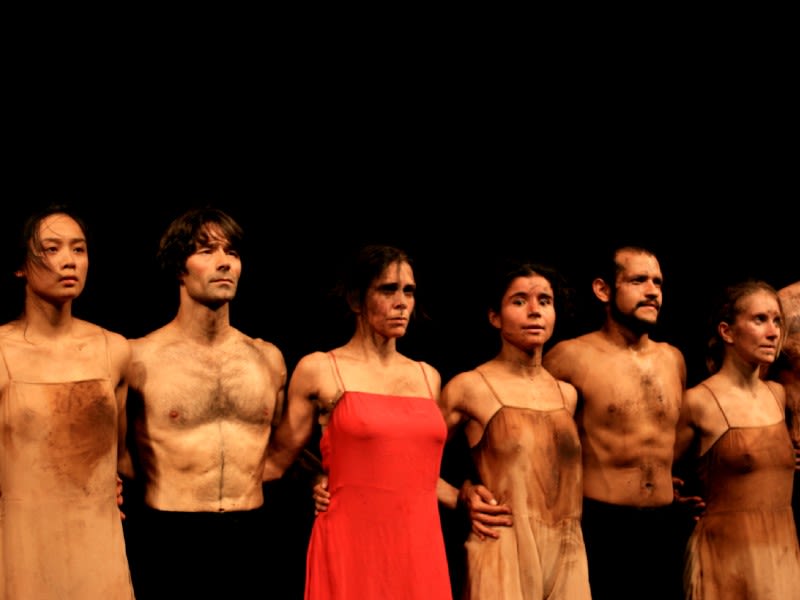
Dancers from Pina Bausch's production of Stravinsky's The Rite of Spring, photo courtesy of Damian HR
More from James
Untitled #1: after Agnes Martin
A piano quintet inspired by the serenity of Agnes Martin's paintings. Performed by Tom Poster and the Kaleidoscope Chamber Collective at the Cheltenham Composer Academy 2019.
Caroline Bordignon
Iridescent Flares III
There is an unusual line of text at the top of the score of Caroline Bordignon’s Iridescent Flares III. In small type, beneath the title, is written: ‘for orchestra and live painting’. Bordignon is an artist as well as a composer, and she has included a live painting element in many of her works. As a synaesthete (like Olivier Messiaen, and another Panufnik Composer Workshop participant from 2016, Deborah Pritchard), she feels the connection between sound and colour as instinctive and personal. She describes her experience of sound as ‘a constant, moving, visual image of iridescent colours and shapes’. Her paintings seek to present a glimpse of that world in parallel with the music itself.
In Iridescent Flares III, Bordignon will paint in front of the orchestra, with her canvas visible to the audience. While her painting will inevitably include some pre-meditated gestures, the synaesthetic image that she is conveying changes according to the performance, so it cannot be wholly pre-planned or predicted. It really is an image of the sound in that moment. And that sound is unmistakably full of colour. Bordignon’s piece for the LSO is the third in an ongoing series for orchestra and painting based on the iridescent colour of light striking a crystal. As music and image unfold in the performance, we also have a sense of time turning into two-dimensional space, like the effect of memory looking back over events. The completed painting at the end, Bordignon says, ‘can be thought of as a remembrance, preserving the musical experience onto canvas’.
Note by Tim Rutherford-Jones
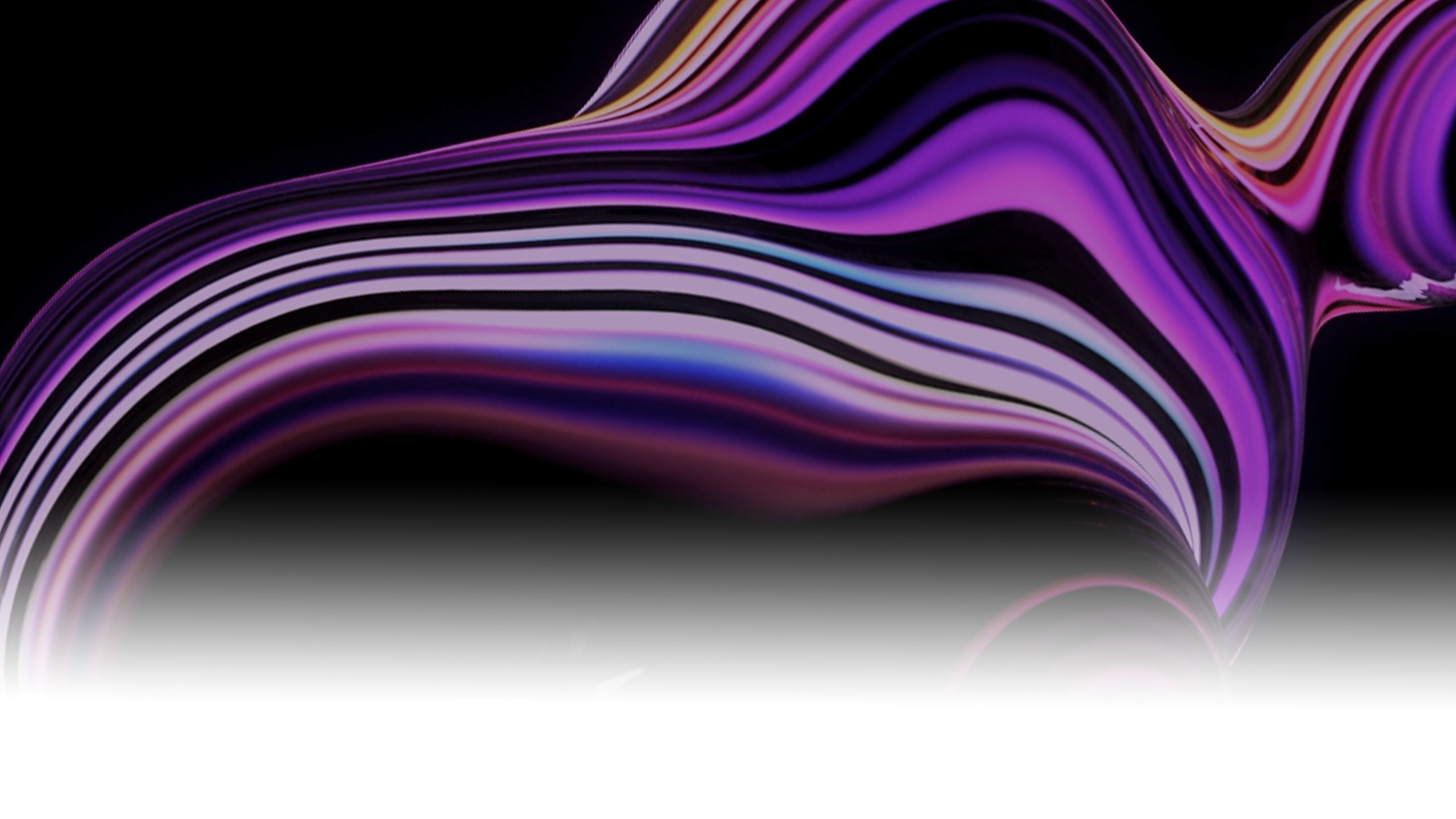
Caroline Bordignon
Caroline Bordignon is a Canadian composer and fine artist based in the UK. Her works have been performed at the Royal Liverpool Philharmonic Music Room, the Illuminate Women's Music Series also broadcast on BBC Radio 3, the Equator Festival at King’s Place London, the International Sound in the Land Music Festival and the Northern Chords Festival. Her artwork has been exhibited in galleries based in Italy, Canada and the UK.
Significant commissions have included Intertwined for singing solo viola by Katherine Clarke, appearing on Classic FM and TwoSet Violin, the second and third movements of Incandescence for string quartet and live painting with the Equilibrium Ensemble at the Royal Liverpool Philharmonic, arrangements of Norwegian Folk Song for soprano Susanna Solsrud in association with the Bergen National Opera, Ultraviolet for the 2020 Illuminate Women's Music Series and five miniatures for solo bassoon and painting with the Birmingham Contemporary Music Group NEXT project performed by Edoardo Casali.
Caroline is currently a PhD Candidate in composition at the Royal Northern College of Music in Manchester, UK with Adam Gorb and Laura Bowler. She seeks to explore aspects of colour, light, space, time and ways in which these interrelate through visual and musical expression synaesthetically. Her focus is to create visual and musical works together with the objective of establishing single, yet varied and complimentary art forms.
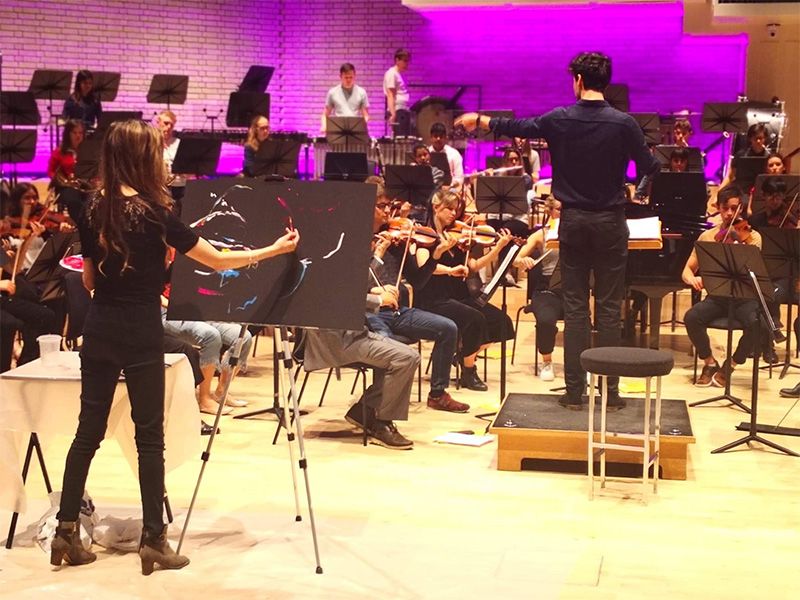
Live painting for orchestra
More from Caroline
Iridescent Flares II
The second work in the cycle for orchestra, IRIDESCENT FLARES, inspired by the visual idea of light striking crystal and the explosions of colour produced.
Joe Bates
Muted the Night
The title of Joe Bates' piece comes from the poem Peter Quince at the Clavier (1915) by the American modernist poet Wallace Stevens (1879–1955). A print of the poem hung above Bates' piano while he composed his piece, and he says it seeped into his writing.
It’s not hard to imagine why. Stevens' poem – based upon the story of Susanna and the Elders from the Bible Book of Daniel – is profoundly sensual and full of musical allusions. It is a form of ‘genuine verbal music’, according to the poet Janet McCann – music is turned into words, words are turned into music.
The line Bates has chosen for his title comes from the poem’s second part. Susanna, who has been bathing in her garden, stands naked on the bank; unbeknownst to her she is watched by two elders, who attempt to blackmail her. Although there are explicit musical references at this point in Stevens’ poem text – a cymbal crash and ‘roaring horns’ – Bates wisely avoids a literal rendition. Instead, he evokes something of the perfumed evening air with richly orchestrated waves of rising arpeggios and scales, using quartertones in several instruments to add a further layer of colour.
Elsewhere in the piece bassoon and cor anglais are asked to play approximately one twelfth of a tone flat: a very small alteration in pitch, but enough to produce a characteristic ‘beating’ effect that thickens the tone somewhat like certain electric organs do. Only in the last few bars is the spell broken as the predominant motion shifts downwards before a brief, hushed coda closing passage.
Note by Tim Rutherford-Jones
On our blog: Joe Bates Woolgar gives us an insight into Muted the Night.

Joe Bates
Joe Bates is a composer and curator making music at the edge of genres. His first musical love was for 20th-century orchestral classics; he spent his teenage years aping Bartók and Ligeti. At university, he became involved in rock and pop, playing in a drag band and running a mixed-genre music night, Filthy Lucre.
Joe’s music is born in the collision of these influences, embracing both orchestral music and synth-heavy electronics. He writes for himself, as a solo electronic performer, and for others, using classical notation. His music is inspired by composers from Kaija Saariaho to Giacinto Scelsi, songwriters like Fiona Apple and D’Angelo, writers like Ursula Le Guin and Derek Parfait, and artists like Hilma Af Klint and Abu Al-Hasan.
Joe’s music blends the riffs and harmonies of rock with structures and instrumentation drawn from contemporary classical music. It combines intense, still riffs and drifting synth sounds with notes that fall through the gaps of the traditional Western scale.
Recent recordings include his choral work Now Is A Long Time, released by NMC Records, and his harp suite, Street Through A Window, whose first movement was record as part of the LSO Coffee Sessions by Bryn Lewis.
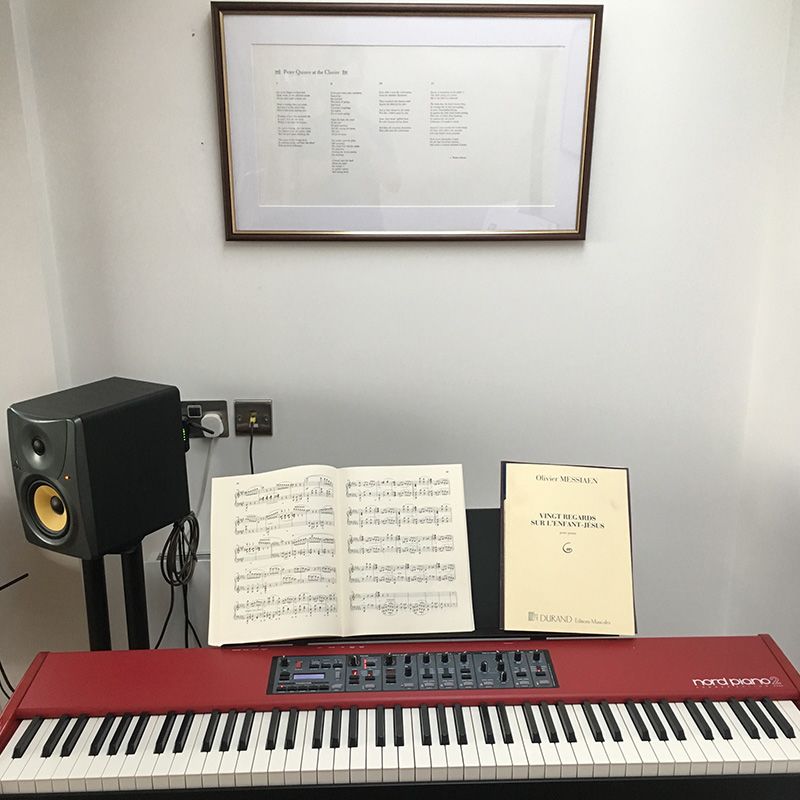
A print of the poem Peter Quince at the Clavier, hung above Joe's keyboard
More from Joe
Now Is A Long Time
A choral work exploring the experience of being stuck indoors, recovering from an accident and the strangeness of time when nothing changes around you. Recorded by the Fellowship of the National Youth Choirs of Great Britain and released by NMC Records.
Jonathan Woolgar
PROTO-SYMPHONY
Three and a half minutes is not enough time in which to fit several movements of a symphony. But what about just their beginnings? Something like this idea lies behind Jonathan Woolgar’s PROTO-SYMPHONY, a grand symphony in its smallest possible form. The effect is double-edged: the 200-odd seconds of the piece itself are rather compressed, almost ‘manic’ in the composer’s words. Yet the music seems also to be very much larger, as if by writing so little, Woolgar has given us great expanses that our minds fill in.
Each ‘movement’ starts confidently enough, but within just a page or so they each quickly fizzle out, leaving hanging the beginning of an idea that the next section attempts to build upon: it’s a symphonic logic, but without the symphony itself; a shadow-play of a grand narrative. A bold opening dissolves into the briefest moment for the violas, gives way to a scherzo that is sustained for a mere eight bars, and is followed by an aborted adagio, an attempt to revive the scherzo (more successfully, this time), and a slow conclusion. In the spirit of open-endedness, the work does not even finish with the customary double barline, but a violin solo that is cut off just as it gets going. ‘The piece isn’t unfinished or to be continued’, explains Woolgar, ‘but it doesn’t resolve fully or completely either – it’s left suspended, almost in a comic way as if to mock the piece’s (intentional) delusions of grandeur’.
Note by Tim Rutherford-Jones
On our blog: Jonathan Woolgar gives us an insight into PROTO-SYMPHONY.

Jonathan Woolgar
Jonathan Woolgar draws from a wide range of musical experience to create work that is communicative without compromise. His music has been performed at the Wigmore Hall, Royal Albert Hall and Basilica San Marco, Venice, by performers such as Héloïse Werner, the Aurora Orchestra and the Helsingborg Symphony Orchestra, as well as broadcast several times on BBC Radio 3. Jonathan is a 2020/21 Royal Philharmonic Society composer, and current projects include a commission for the 2021 Cheltenham Music Festival.
Whilst currently based in London, Jonathan originally hails from Pontefract in West Yorkshire. He attended Chetham’s School of Music, Manchester from 2008–10, studying composition with Jeremy Pike and Gavin Wayte. He then read music at Fitzwilliam College, Cambridge where he studied composition with Giles Swayne, before going on to learn with David Sawer at the Royal Academy of Music. He is currently finishing a PhD at the Guildhall School of Music & Drama supervised by Julian Anderson, alongside an active teaching career.
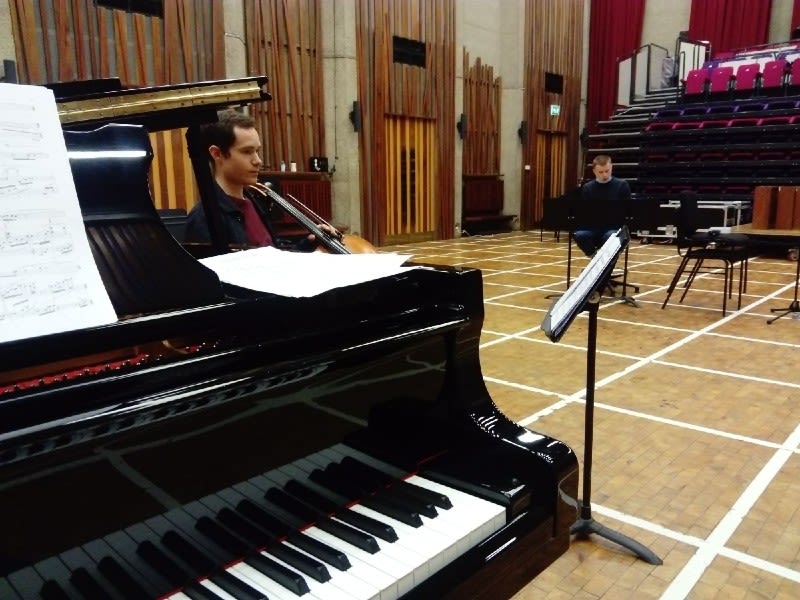
Recording Cello Messages
More from Jonathan
Cello Messages
A 30-minute, five-movement piece written for cellist Joe Davies and pianist Daniel Chappell, exploring the spectrum between musical eloquence and ineloquence. Listen below.
Louise Drewett
The Daymark
The starting materials of Louise Drewett’s The Daymark are outwardly very simple indeed: a seven-note descending scale in D major, played initially by a trio of bassoons. Yet what Drewett does is deceptively complicated. For one thing, the bassoons do not play quite the same thing: they follow the same pitch patterns, but rhythmically out of sync with each other. The same idea is picked up by three clarinets a few bars later, and then in various forms throughout the piece. Meanwhile, slower chords in the strings and horns, and splashes from the percussion and harp pick out fragments of the same scales and turn them into independent instrumental layers. The effect is something like the refraction of light as it hits a prism and is split into different speeds and colours. As the piece progresses, the different layers draw together even as they peel apart, pulling the music through a series of luminous climaxes and changes of texture.
The Daymark itself is an octagonal stone beacon built in 1864 on the Devon coast as an aid for finding Dartmouth harbour from the sea. Standing on eight long arched legs it resembles an octopus, swimming upwards, or an arcane spaceship. Twenty-four metres tall, it works by dint of size alone, yet its octagonal shape means that it always reflects the light in interesting ways, and as the sun sets it can be glimpsed as a point of light between its arches.
Note by Tim Rutherford-Jones

Louise Drewett
Louise Drewett is a London-based composer, performer and teacher. She writes music for a wide range of projects, and co-directs and writes for Sing Healthy, an organisation that runs community choirs in Berkshire. Since 2012 Louise has collaborated with theatre company Arbonauts, most recently for productions at Inside Out Dorset and Latitude Festivals. She also collaborates with poet Clare Shaw, writing songs for solo voices and choir. Louise’s work has been performed at Westminster Abbey, Salisbury Cathedral, St George’s Chapel, Wigmore Hall and many other venues in the UK and internationally.
Louise is currently studying towards a PhD in composition on a scholarship at the Royal Academy of Music, supervised by Philip Cashian. She gained an MMus with Distinction from the same institution in 2018. Her postgraduate study has been generously supported by the Charles Lucas Memorial Fund, the Countess of Munster Musical Trust and a Vaughan Williams Bursary from the RVW Trust. She won Charles Lucas Composition Prizes in 2018 and 2019.
Previously, Louise studied composition with Giles Swayne, and has studied with Michael Finnissy both as a Britten-Pears Young Artist at
Aldeburgh Music, and on the Advanced Composition course at
Dartington International Summer School.
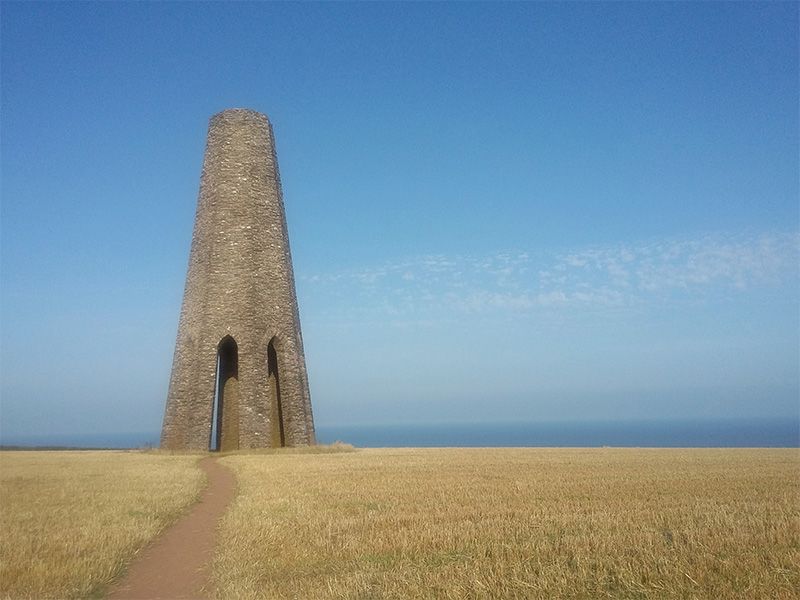
The 'Daymark' day beacon in Devon
More from Louise
Tree of Hundreds
A five-minute solo guitar piece written last year for the International Guitar Foundation and premiered by IGF Young Artist Pavel Ralev. The piece was inspired by a visit to an ancient tree called Ankerwycke Yew.
Artist Biographies

Jack Sheen
conductor
Jack Sheen (1993) is a conductor and composer from Manchester. He regularly works with leading orchestras, ensembles, galleries and artists on concert and operatic performances, commissions, installations and interdisciplinary projects. 2021 will see Jack debut with the London Symphony Orchestra, Britten Sinfonia, and FontanaMIX Ensemble in diverse programmes including premieres of his own music, return to the Lucerne Festival Academy as a Conducting Fellow, create a new sound-installation for the Venice Biennale Musica, complete new concert music and performance-installations for Octandre Ensemble, take up an artist residency at PINK Gallery in Manchester’s city centre, and complete his tenure as Carne Fellow at Trinity Laban Conservatoire of Music & Dance, the first ever composer to hold this position.
He is the Co-Director of London Contemporary Music Festival (‘the capital’s most adventurous and ambitious festival of new music’ The Guardian, ‘London’s most important festival’, The Wire) and Co-Founder of the critically acclaimed LCMF Orchestra.
Equally at home with core repertoire and radical contemporary work, Jack was a 2019 Tanglewood Conducting Fellow and has conducted orchestras around Europe such as the BBC Philharmonic, Hallé, London Sinfonietta, Royal Northern Sinfonia and Halberstadt Orchestra, alongside some of the Europe’s most progressive ensembles, including Apartment House, EXAUDI and Ensemble Linea, in venues such as the Barbican, Bridgewater Hall and Wigmore Hall. Recent opera productions include Humperdinck’s Hansel und Gretel, Puccini’s Gianni Schicchi, and Henning Christiansen’s Dejligt vejr i dag, n'est-ce pas, Ibsen.
Jack is an alumnus of the LSO Panufnik Composers Scheme (2014) and received a commission to write a 10-minute piece for the LSO. Lung was premiered at the Barbican in September 2016.
London Symphony Orchestra
The London Symphony Orchestra was established in 1904, and is built on the belief that extraordinary music should be available to everyone, everywhere.
Through inspiring music, educational programmes and technological innovations, the LSO’s reach extends far beyond the concert hall.
Visit our website to find out more.

On Stage
Leader
Carmine Lauri
First Violins
Clare Duckworth
Laura Dixon
Maxine Kwok
William Melvin
Elizabeth Pigram
Laurent Quénelle
Harriet Rayfield
Second Violins
David Alberman
Sarah Quinn
Miya Väisänen
David Ballesteros
Matthew Gardner
Naoko Keatley
Iwona Muszynska
Andrew Pollock
Violas
Edward Vanderspar
Gillianne Haddow
Malcolm Johnston
German Clavijo
Sofia Silva Sousa
Cellos
Rebecca Gilliver
Jennifer Brown
Noel Bradshaw
Daniel Gardner
Laure Le Dantec
Amanda Truelove
Double Basses
Colin Paris
Patrick Laurence
Thomas Goodman
Flutes
Gareth Davies
Jack Welch
Piccolo
Sharon Williams
Oboes
Juliana Koch
Rosie Jenkins
Cor Anglais
Maxwell Spiers
Clarinets
Chris Richards
Chi-Yu Mo
Bass Clarinet
Andrew Harper
Bassoons
Daniel Jemison
Dominic Tyler
Contra Bassoon
Martin Field
Horns
Timothy Jones
Jonathan Maloney
Alexander Edmundson
Finlay Bain
Trumpets
Paul Beniston
Kaitlin Wild
Niall Keatley
Trombones
Peter Moore
Philip White
Bass Trombone
Paul Milner
Tuba
Ben Thomson
Timpani
Nigel Thomas
Percussion
Neil Percy
David Jackson
Sam Walton
Harp
Bryn Lewis
Piano
Elizabeth Burley
Meet the Members of the LSO on our website

Come and see us at the Barbican …
LSO FUTURES
Sunday 13 June, 3.30pm & 6.30pm
A concert devoted to music that simply demands to be heard.
Violinist extraordinaire Patricia Kopatchinskaja gives the UK premiere of a brand new concerto, written specially for her by the Spanish composer Francisco Coll, who came through LSO Discovery's Panufnik Composers Scheme in 2009.
Music constantly renews itself, and LSO Futures showcases two more striking orchestral works, also by Panufnik scheme alumni: Charlie Piper and Ayanna Witter-Johnson. All this alongside an undisputed 21st-century classic by living legend Betsy Jolas.
Programme Contributors
Tim Rutherford-Johnson is a writer, speaker and teacher on contemporary music. His first book, Music after the Fall: Modern Composition and Culture since 1989 was published in February 2017 by University of California Press.
